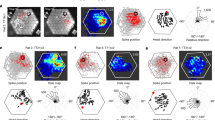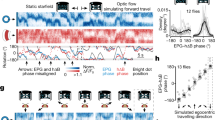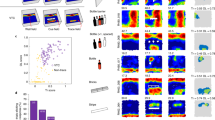Abstract
During short foraging excursions away from their home, central place foragers update their position relative to their point of departure by processing signals generated by locomotion. They therefore can home along a self-generated vector without using learned references. In rodents1,2,3,4,5 and other mammals6,7, this path integration process (dead reckoning) can occur on the basis of purely internal signals, such as vestibular8 or proprioceptive (re)afferences6. We report here that hamsters are also capable of proceeding to a previously learned feeding site through vector information from locomotion only. The subjects compute9 the direction and distance to the goal by subtracting their current-position vector from the stored nest-to-goal vector. This computation pertains to locations per se and therefore occurs in absolute space, independently of landmark objects. If available, prominent visual cues merely serve to confirm the path planned through the addition of self-generated vectors, whereas visual as well as non-visual references confirm that the subject has arrived at the goal site.
This is a preview of subscription content, access via your institution
Access options
Subscribe to this journal
Receive 51 print issues and online access
$199.00 per year
only $3.90 per issue
Buy this article
- Purchase on Springer Link
- Instant access to full article PDF
Prices may be subject to local taxes which are calculated during checkout



Similar content being viewed by others
References
Alyan, S. & Jander, R. Short-range homing in the house mouse, Mus musculus: Stages in the learning of directions. Anim. Behav. 48, 285–298 (1994).
Benhamou, S. Path integration by swimming rats. Anim. Behav. 54, 321–327 (1997).
Etienne, A. S. Navigation of a small mammal by dead reckoning and local cues. Curr. Dir. Psych. Sci. 1, 48–52 (1992).
Mittelstaedt, H. & Mittelstaedt, M. L. in Avian Navigation (eds Papi, F. & Wallraff, H. G.) 290–297 (Springer, Berlin, 1982).
Potegal, M. in Cognitive Processes and Spatial Orientation in Animal and Man Vol. 2 (eds Ellen, P. & Thinus-Blanc, C.) 28–34 (M. Nijhoff, Dordrecht, (1987).
Etienne, A. S., Maurer, R. & Séguinot, V. Path integration in mammals and its interaction with visual landmarks. J. Exp. Biol. 199, 201–209 (1996).
Séguinot, V., Cattet, J. & Benhamou, S. Path integration in dogs. Anim. Behav. 55, 787–979 (1997).
Wiener, S. & Berthoz, A. in Multisensory Control of Movement (ed. Berthoz, A.) 427–456 (Oxford University Press, Oxford, (1993).
Maurer, R. & Séguinot, V. What is modelling for? A critical review of the models of path integration. J. Theor. Biol. 175, 457–475 (1995).
Gallistel, C. R. The Organization of Learning (MIT Press, Cambridge, Massachusetts, (1990).
Etienne, A. S., Maurer, R. & Saucy, F. Limitations in the assessment of path dependent information. Behaviour 106, 81–111 (1988).
Collett, T. S., Cartwright, B. A. & Smith, B. A. Landmark learning and visuo-spatial memories in gerbils. J. Comp. Physiol A 158, 835–851 (1986).
Etienne, A. S., Vauclair, J., Emmanuelli, E., Lançon, M. & Stryjenski, J. Depth perception by means of ambient sounds in a small mammal. Experientia 38, 553–555 (1982).
Séguinot, V., Maurer, R. & Etienne, A. S. Dead reckoning in a small mammal: the evaluation of distance. J. Comp. Physiol. A 173, 103–113 (1993).
Cheng, K. The vector sum model of pigeon landmark use. J. Exp. Psychol., Anim. Behav. Proc. 15, 366–375 (1989).
McNaughton, B. L., Chen, L. L. & Markus, E. J. “Dead reckoning”, landmark learning, and the sense of direction: a neurophysiological and computational hypothesis. J. Cogn. Neurosci. 3, 190–202 (1991).
Alyan, S. & Jander, R. Interplay of directional navigation mechanisms as a function of near-goal distance: experiments with the house mouse. Behav. Proc. 41, 245–255 (1997).
Acknowledgements
This research was supported by the Swiss National Science Foundation. We thank A.Kfouri for his suggestions and R. Schumacher for his technical assistance.
Author information
Authors and Affiliations
Corresponding authors
Rights and permissions
About this article
Cite this article
Etienne, A., Maurer, R., Berlie, J. et al. Navigation through vector addition. Nature 396, 161–164 (1998). https://doi.org/10.1038/24151
Received:
Accepted:
Issue Date:
DOI: https://doi.org/10.1038/24151
This article is cited by
-
A stable hippocampal code in freely flying bats
Nature (2022)
-
Evidence for cognitive impairment in patients with vestibular disorders
Journal of Neurology (2022)
-
Rats (Rattus norvegicus) flexibly retrieve objects’ non-spatial and spatial information from their visuospatial working memory: effects of integrated and separate processing of these features in a missing-object recognition task
Animal Cognition (2016)
-
Spatial cognition in bats and rats: from sensory acquisition to multiscale maps and navigation
Nature Reviews Neuroscience (2015)
-
Navigation outside of the box: what the lab can learn from the field and what the field can learn from the lab
Movement Ecology (2014)
Comments
By submitting a comment you agree to abide by our Terms and Community Guidelines. If you find something abusive or that does not comply with our terms or guidelines please flag it as inappropriate.



